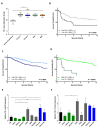Drug Resistance in Medulloblastoma Is Driven by YB-1, ABCB1 and a Seven-Gene Drug Signature
- PMID: 36831428
- PMCID: PMC9954169
- DOI: 10.3390/cancers15041086
Drug Resistance in Medulloblastoma Is Driven by YB-1, ABCB1 and a Seven-Gene Drug Signature
Abstract
Therapy resistance represents an unmet challenge in the treatment of medulloblastoma. Accordingly, the identification of targets that mark drug-resistant cell populations, or drive the proliferation of resistant cells, may improve treatment strategies. To address this, we undertook a targeted approach focused on the multi-functional transcription factor YB-1. Genetic knockdown of YB-1 in Group 3 medulloblastoma cell lines diminished cell invasion in 3D in vitro assays and increased sensitivity to standard-of-care chemotherapeutic vincristine and anti-cancer agents panobinostat and JQ1. For vincristine, this occurred in part by YB-1-mediated transcriptional regulation of multi-drug resistance gene ABCB1, as determined by chromatin immunoprecipitation. Whole transcriptome sequencing of YB-1 knockdown cells identified a role for YB-1 in the regulation of tumourigenic processes, including lipid metabolism, cell death and survival and MYC and mTOR pathways. Stable cisplatin- and vincristine-tolerant Group 3 and SHH cell lines were generated to identify additional mechanisms driving resistance to standard-of-care medulloblastoma therapy. Next-generation sequencing revealed a vastly different transcriptomic landscape following chronic drug exposure, including a drug-tolerant seven-gene expression signature, common to all sequenced drug-tolerant cell lines, representing therapeutically targetable genes implicated in the acquisition of drug tolerance. Our findings provide significant insight into mechanisms and genes underlying therapy resistance in medulloblastoma.
Keywords: ABC transporter; YB-1; cancer cell invasion; drug resistance; medulloblastoma; metastasis; vincristine.
Conflict of interest statement
The authors declare no conflict of interest. The funders had no role in the design of the study; in the collection, analyses, or interpretation of data; in the writing of the manuscript; or in the decision to publish the results.
Figures





References
-
- Sharma T., Schwalbe E., Williamson D., Sill M., Hovestadt V., Mynarek M., Rutkowski S., Robinson G., Gajjar A., Cavalli F., et al. Second-generation molecular subgrouping of medulloblastoma: An international meta-analysis of Group 3 and Group 4 subtypes. Acta Neuropathol. 2019;138:309–326. doi: 10.1007/s00401-019-02020-0. - DOI - PMC - PubMed
-
- Hill R.M., Richardson S., Schwalbe E.C., Hicks D., Lindsey J.C., Crosier S., Rafiee G., Grabovska Y., Wharton S.B., Jacques T.S., et al. Time, pattern, and outcome of medulloblastoma relapse and their association with tumour biology at diagnosis and therapy: A multicentre cohort study. Lancet Child Adolesc. Health. 2020;4:865–874. doi: 10.1016/S2352-4642(20)30246-7. - DOI - PMC - PubMed
-
- Bertrand K.C., Faria C.C., Skowron P., Luck A., Garzia L., Wu X., Agnihotri S., Smith C.A., Taylor M.D., Mack S.C., et al. A functional genomics approach to identify pathways of drug resistance in medulloblastoma. Acta Neuropathol. Commun. 2018;6:146. doi: 10.1186/s40478-018-0652-8. - DOI - PMC - PubMed
Grants and funding
LinkOut - more resources
Full Text Sources
Miscellaneous

